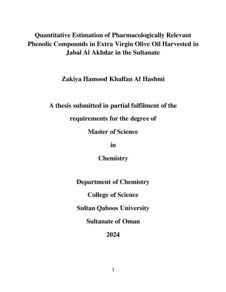Document
Quantitative estimation of pharmacologically relevant phenolic compounds in extra virgin olive oil harvested in Jabal Al Akhdar in the Sultanate.
Source
Master's thesis
Other titles
التقدير الكمي للمركبات الفينولية ذات التأثير الصيدلاني في زيت الزيتون المحصود في الجبل الأخضر في سلطنة عمان
Country
Oman
City
Muscat
Publisher
Sultan Qaboos University
Gregorian
2024
Language
English
Thesis Type
Master's thesis
English abstract
Extra virgin olive oil (EVOO) is a well-known source of health benefits due to its phenolic compounds, including hydroxytyrosol and tyrosol. These compounds provide antioxidant and anti inflammatory effects, reducing inflammation and protecting against conditions such as atherosclerosis. Consuming EVOO rich in phenols is linked to a lower risk of coronary heart disease by combating oxidative stress and inflammation. Additionally, secoiridoids like oleacein and oleocanthal show potential in combating inflammation-related conditions like cancer and neurodegenerative disorders. In Oman, various types of olives, from different countries, are being harvested in Jabal Al Akhdar.
The chemical composition of EVOO is significantly influenced by factors such as variety, climate, soil, and environment. Therefore, this study focuses on analyzing specific chemical components in various types of EVOO from Jabal Al Akhdar in Oman, like hydroxytyrosol, tyrosol, oleacein, and oleocanthal (OHTs) due to their health benefits. The ultimate objective of this study is to limit the farming at Jabal Al Akhdar to the varieties that are rich in OHTs. To achieve this goal, EVOO samples were collected from different sources; Riyad Al Jabal Farm and other farms in Al Jabal Al Akhdar, and analyzed for OHTs using a standard method with some modifications. Riyad Al Jabal Farm is under the administration of the Royal Court Affair, Sultanate of Oman. The olive trees in this farm were planted in January 2010 and treated similarly. Liquid chromatography tandem mass spectrometry (LC-MS/MS) was used for qualitative analysis while quantitative analysis was carried out using high performance liquid chromatography (HPLC) coupled to a photodiode array detector. The method showed strong linear relationships with correlation coefficients between 0.978 and 0.999, indicating its reliability.
The study revealed that certain EVOO varieties like Carotina (181.2 ± 0.1) mg kg-1 , Kalamata (137.16± 0.09) mg kg-1 and Picual (107.7± 0.3) mg kg-1 , exhibit highest concentration of OHTs, making them favourable choices for cultivation in Jabal Al Akhdar. Additionally, the Folin-Ciocalteu reagent method (F C) was utilized to estimate the total phenolic content of EVOO extracts. Results indicated varying levels of phenolic compounds among different EVOO varieties, with Picual (254.6± 5.2) mg kg-1 vii and Carotina (240.6± 5.6) mg kg-1 demonstrating the highest content. Based on these findings, the Government distributed 200 seedlings of the selected varieties (Carotina, Kalamata and Picual) to the farmers in Jabal Al Akhdar aiming to produce a higher quality of olive oil.
Category
Theses and Dissertations

